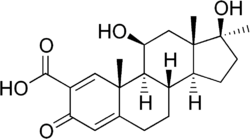Chemistry:Roxibolone
 | |
| Clinical data | |
|---|---|
| Other names | BR-906; 11β,17β-Dihydroxy-17α-methyl-3-oxoandrosta-1,4-diene-2-carboxylic acid |
| Identifiers | |
| |
| CAS Number | |
| PubChem CID | |
| ChemSpider | |
| UNII | |
| Chemical and physical data | |
| Formula | C21H28O5 |
| Molar mass | 360.450 g·mol−1 |
| 3D model (JSmol) | |
| |
| |
| | |
Roxibolone (INN) (developmental code name BR-906), also known as 11β,17β-dihydroxy-17α-methyl-3-oxoandrosta-1,4-diene-2-carboxylic acid, is a steroidal antiglucocorticoid described as an anticholesterolemic (cholesterol-lowering) and anabolic drug which was never marketed.[1][2] Roxibolone is closely related to formebolone, which shows antiglucocorticoid activity similarly and, with the exception of having a carboxaldehyde group at the C2 position instead of a carboxylic acid group, roxibolone is structurally almost identical to.[2] The 2-decyl ester of roxibolone, decylroxibolone (developmental code name BR-917), is a long-acting prodrug of roxibolone with similar activity.[1][2]
In rats, roxibolone counteracts the catabolic effects (control of nitrogen balance) and increased alkaline phosphatase levels induced by the potent glucocorticoid dexamethasone phosphate.[2] It does not bind to the glucocorticoid receptor however, and its antiglucocorticoid activity may instead be mediated by enzyme inhibition.[3] In accordance, 11α- and 11β-hydroxyprogesterone are known to be potent inhibitors of 11β-hydroxysteroid dehydrogenase (11β-HSD), which is responsible for the biosynthesis of the potent endogenous glucocorticoids cortisol and corticosterone (from the precursors deoxycortisol and deoxycorticosterone, respectively).[4][5] As roxibolone is 11β-hydroxylated similarly, it may act in a likewise fashion. However, formebolone was found to be a very weak inhibitor of 11β-HSD type 2, although this specific isoenzyme is responsible for the inactivation of glucocorticoids rather than their production.[6]
Unlike formebolone, which is additionally an anabolic-androgenic steroid (AAS), roxibolone is devoid of affinity for the androgen receptor and possesses no androgenic or myotrophic activity in animal assays.[2] For this reason, it has been said that roxibolone may be much better tolerated in comparison.[2]
References
- ↑ 1.0 1.1 J. Elks (14 November 2014). The Dictionary of Drugs: Chemical Data: Chemical Data, Structures and Bibliographies. Springer. p. 1082. ISBN 978-1-4757-2085-3. https://books.google.com/books?id=0vXTBwAAQBAJ&pg=RA1-PA586.
- ↑ 2.0 2.1 2.2 2.3 2.4 2.5 "Synthesis of 2-carboxy-11 beta, 17 beta-dihydroxy-17-methyl-1, 4-androstadien-3-one and related compounds". Steroids 43 (3): 271–82. 1984. doi:10.1016/0039-128x(84)90045-x. PMID 6523544.
- ↑ "Regulation of the androgen and glucocorticoid receptors in rat and mouse skeletal muscle cytosol". Endocrinology 108 (4): 1431–40. 1981. doi:10.1210/endo-108-4-1431. PMID 6970661.
- ↑ "11 alpha- and 11 beta-hydroxyprogesterone, potent inhibitors of 11 beta-hydroxysteroid dehydrogenase (isoforms 1 and 2), confer marked mineralocorticoid activity on corticosterone in the ADX rat". Endocrinology 136 (4): 1809–12. 1995. doi:10.1210/endo.136.4.7895695. PMID 7895695.
- ↑ "11 alpha- and 11 beta-hydroxyprogesterone, potent inhibitors of 11 beta-hydroxysteroid dehydrogenase, possess hypertensinogenic activity in the rat". Hypertension 27 (3 Pt 1): 421–5. 1996. doi:10.1161/01.hyp.27.3.421. PMID 8698448.
- ↑ "The anabolic androgenic steroid fluoxymesterone inhibits 11β-hydroxysteroid dehydrogenase 2-dependent glucocorticoid inactivation". Toxicol. Sci. 126 (2): 353–61. 2012. doi:10.1093/toxsci/kfs022. PMID 22273746.
 |

